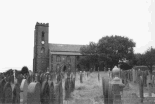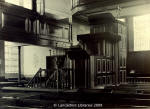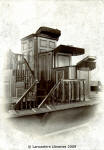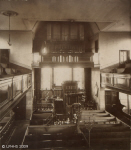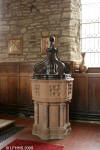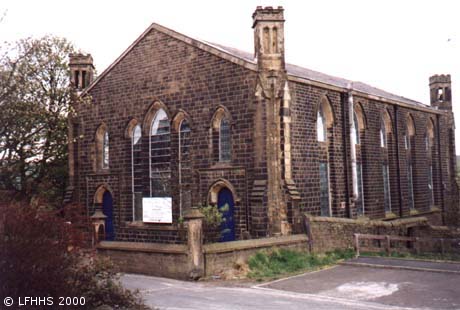
Goodshaw
The origins of Goodshaw
The first church
In the middle ages Goodshaw was one of eleven hamlets situated within the royal Forest of Rossendale. The name probably means "God's Wood" and suggests that this was a centre of Celtic worship. Rossendale had few inhabitants until the beginning of the sixteenth century when King Henry VII ordered the deer to be killed and the land sold. From that date the population grew quickly and in 1511 a church was built at Newchurch, then in the parish of Whalley. This church proved inadequate for the growing population and in 1542 it was agreed to build a second church at Goodshaw.
The parish records preserve a seventeenth century copy of the original deed for the building of a church at Goodshaw, dated in the thirty-second year of the reign of King Henry VIII (1542).
This deed records:-
"that it is agreed between the said parties that they shall found, edify and build one chapel in the Honour of God, our Blessed Lady and All Saints in a certain place in the Forest of Rossendale named Morrell Height for the easement of the said parties, and their neighbours, the inhabitants of Crawshawbooth, Gambleside, Goodshaw and Loveclough and all others, the King's liege people which shall be disposed to hear Mass and other Divine Services in the said Chapel."
The first Goodshaw Church, known as "Old Dunkirk" was a chapel-of-ease to Whalley, and was only a small structure - the original deed describes it as being 16 yards long and 7 yards wide, with walls 3 yards high, two doors three windows and a thatched roof. Very little else is known about Goodshaw at this time when England was torn by the religious changes of the reformation. In 1550, in the reign of King Edward VI Goodshaw became part of the new parish of Newchurch, and its inhabitants were required to go to Church there. This was obviously unpopular for in 1584 Queen Elizabeth granted the petition that the inhabitants of Goodshaw and the surrounding hamlets (known as "Higher Booths") should attend Church at Haslingden, Goodshaw remained a chapel of Haslingden until 1849.
On 25th June 1650, during the interregnum after the Civil War, when England had no King, an inquisition was held at Blackburn before Richard Shuttleworth Esq. and others. They acted by Commission under the Commonwealth Seal "for enquiry and serving the number and value of the parochial vocations etc. within the parishes of Whalley, Blackburn and Rochdale". Goodshaw was then in the parish of Whalley and it was recorded that:-
"Goodshaw is a chapelry consisting of seventy families, but no means of maintenance saving a messuage and backside, value 10/-: and that the inhabitants desire to be made a parish."
The second Church
The only evidence which we posses to prove the existence of a second church at Goodshaw, distinct from the original chapel of 1542, and from the present building, is two seating plans bearing the dates 1740 and 1794. Clearly this second church was much larger than the first, and it could seat 234 people. The plan of 1740 shows a tower at the west end, while that of 1794 shows a singing pew in front of the large "three- decker" pulpit. This pulpit was retained the church was rebuilt in 1828 and survived until 1903. It is recorded that the sounding board over the pulpit fell down only a few seconds after the Rev. George Haworth had finished his sermon and descended.
In the early eighteenth century Goodshaw was served by the curates of Haslingden, and in 1704 the Curate reported to the Bishop of Chester:-
"Goodshaw, a chapel within Haslingden...... I preach there sometimes but have nothing for my pains."
However in 1730 Goodshaw got a curate of its own - a Mr. John Uttley who stayed until about 1770. It was in his time that John Wesley preached at Goodshaw, and he recorded in his diary for Sunday 28th August 1747:-
"I was invited by Mr. Uttley the Minister of Goodshaw, to preach in his Church. I began reading prayers at seven but perceiving the church would scarce contain half of the congregation, after prayers I went out, and standing on the church-yard wall, in a place shaded from the sun, explained and enforced those words of the second lesson. "Almost Thou persuadest me to be a Christian."
There is still in existence an interesting deed regarding the purchase of the church-yard at this time. It is dated 1824 and records a transaction made by the Halmot Court of the Manor Accrington in which Goodshaw lies. The land was bought in the name of the minister of Goodshaw, the Rev. George Haworth, for £37-8s-6d., and he was required to pay an annual rent of one farthing to Elizabeth, Duchess Dowager of Buccleuch and Queensbury, who was then Lady of the Manor.
It was during this period that the registers of the church were begun. The first record is that of a baptism in 1732.
The third Church
The present church bears the date 1828 - carved in two stone shields above the east window. A tablet, which used to hang on the vestry wall recorded:-
"This chapel was rebuilt and enlarge in the year 1829 by which means, 424 additional sittings were obtained, and in consequence of the grant from the Society for Promoting the enlargement and Building of churches and Chapels. 300 of that number are hereby declared to be free and unappropriated for ever, in addtion to 57 formerly provided.
GEORGE HAWORTH Minister.
JAMES SANDERSON. EDMOND BUTTERWORTH Wardens.
The sundial on the south wall of the church bears the date AD 1831 and the Latin inscription "UT HORA SIC VITA CARPE DIEM" - "As the hour passes so does life: enjoy the day". A chalice, paten and flagon of beautiful Georgian silver were given to the new church in 1830. Each piece bears the inscription "Gift of Henry Butterworth - Sunnyside - to Goodshaw chapel - 1830"
It was only in 1837 that Goodshaw Church was licensed for marriages, but in 1849 an Order in Council of Queen Victoria made Goodshaw a completely independent parish, and the curate the Rev. James Bell became the first Vicar. It was recorded in the London Gazette for 1867 that the Ecclesiastical Commission granted £77 to the Vicar of Goodshaw.
By 1902 the Church stood in need of extensive repair and it was argued that a new church should be built nearer to the Burnley Road. In the end, however, the old church was restored by a very thorough interior renovation. It was at this time that the interior of the Church took on its present appearance. The old square pews, with their vari coloured draperies, the great three-decker pulpit in front of the alter, and the organ and singing-pews at the east end - all were removed in the restoration. When the pulpit was taken down, some writing in chalk was found underneath, saying that while the pulpit was being erected three gallons of rum were drunk!
Two arches in pink sandstone were built, one at the east end to form a sanctuary and the other at the west where an extension was made to form a porch and baptistry. The Hon. Marshall Brooks, gave the reredos and the font - both constructed of sandstone and marble. The chancel was extended by building the vestries and choir stalls, while the organ was rebuilt in its present position in the north gallery. When the old flat plaster ceiling was removed, the fine oak beams of the roof came into view. The pulpit was a gift from the Mothers Union.
In 1920 the walls of the sanctuary were faced with pink sandstone as a war memorial, with the inscription:- "Thanks be to God who giveth us the victory."
A brass tablet on the east wall of the choir stall is inscribed with the names of those from the parish who died in the Great War 1914-1918.
The stained-glass windows above the altar are in memory of Mrs. Florence Brooks, the centre window was given by her husband, and the side windows by the Girls Friendly Society. The central figures, representing Faith, Hope and Charity, are based on a window in the chapel of New College, Oxford, designed by the great painter Sir Joshua Reynolds.
The Church was again restored in 1928 by the benefaction of Susanah Gott. The most recent restoration in 1965 in memory of James Henry Barrow, and a screen of oak and glass was constructed between the baptistry and the nave.
Day and Sunday Schools
The first school associated with Goodshaw Church was the so-called "Old School" which now forms part of Central School, just below the church. This was built as a non-denominational school in 1811, and the original agreement to build "a school-house at Goodshaw" is still in existence, dated 1810. The agreement was made in the Accrington Manor Court of Henry, Duke of Buccleuch, and the school was to provide a "master to teach reading, writing and arithmetic," The "Old School" remained a day school only until 1836, since when it has been a Sunday School. The building was enlarged in 1886.
The "Old School" was replaced by two schools built by the National Schools Society of the Church England. Crawshawbooth National School was built in 1806 and enlarged in 1879(later known as St John's School). Loveclough National School was built in 1846. Clowbridge School became part of the Parish of Goodshaw only in 1925, until when it had belonged to the Parish of St Leonard, Padiham. It served as day school, Sunday school and as the mission church of St James until it was finally closed in 1963.
The Curates and Vicars of Goodshaw
| Curates | ||
| 1730 - 1770 .......... Rev. John Uttley | ||
| 1781 - 1788 .......... Rev. Richard Ortt | ||
| 1789 - 1790 .......... Rev. John Bailey | ||
| 1790 - 1800 .......... Rev. George Casson | ||
| 1801 - 1812 .......... Rev. John Dawes | ||
| 1813 - 1813 .......... Rev. John Haworth | ||
| 1814 - 1836 .......... Rev. George Haworth | ||
| 1836 - 1839 .......... Rev. Ebenezer Brown Allen | ||
| 1839 - 1847 .......... Rev. Henry Haworth | ||
| Vicars | ||
| 1848 - 1854 .......... Rev. James Bell - first Vicar 1849 | ||
| 1854 - 1887 .......... Rev. John Howard | ||
| 1887 - 1892 .......... Rev. Abraham Spencer | ||
| 1892 - 1899 .......... Rev. Alfred Bedson | ||
| 1899 - 1904 .......... Rev. Richard Newman | ||
| 1905 - 1909 .......... Rev. James William Wilkinson | ||
| 1909 - 1912 .......... Rev. Dr Alfred Edward Rubie | ||
| 1913 - 1925 .......... Rev. Harry Stones | ||
| 1926 - 1939 .......... Rev. John Lund | ||
| 1939 - 1951 .......... Rev. J. L. Street | ||
| 1952 - 1956 .......... Rev. A. R. H. Greaves | ||
| 1956 - 1957 .......... Rev C. A. Royal | ||
| 1957 - 1961 .......... Rev. S. Pearson | ||
| 1962 - 1968 .......... Rev. F. J. Gilbert | ||
| 1968 - 1981 .......... Rev. Colin Barnes | ||
| 1981 - 1993 .......... Rev Canon Ralph Edward Mallinson | ||
| 1994 - 1998 .......... Rev Dr John Andrew Armes | ||
| 1999 - 2008 .......... Rev Wendy L. Oliver | ||
| 2010 - 2018 .......... Rev Jennifer Montgomery | ||
| 2018 - 2020 .......... Rev Chris Casey | ||
| Curates | ||
| 1988 - 1993 .......... Rev. Alice Gillian Swallow | ||
| 1994 - 1999 .......... Rev. Eric John Lomax |
The Parish Registers of St Mary & All Saints
Listed in the table below are the registers available to the Rossendale Branch. These are either with the Branch or at Rawtenstall Library Local Studies Department.
| Register type and years covered | Film | Book | Indexed | At Church |
| Burials 1813-1841 | X | X | X | |
| Burials 1841-1893 | X | X | ||
| Burials 1893-1946 | X | X | X | |
| Burials 1946- | X | X | X | |
| Grave Register - South plot | X | X | X | |
| Baptisms 1813-1854 | X | |||
| Baptisms 1854-1899 | X | X | ||
| Baptisms 1900-1999 | X | X | X | |
| Marriages 1837-1907 | X | X | ||
| Marriages 1907-1991 | X | X | X | |
| Monument Inscriptions - South plot | X | X | ||
| Monument Inscriptions - East plot | X | X | ||
| Monument Inscriptions - North plot | X | X | ||
| Burials & Baptisms 1732-1812 | X |

